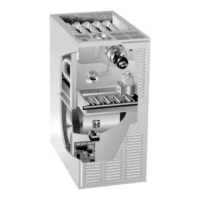Page 12
Venting Using a Masonry Chimney
The following additional requirements apply when a lined
masonry chimney is used to vent an G24M furnace.
Masonry chimneys used to vent Category I central furĆ
naces must be either tileĆlined or lined with a listed metal
lining system or dedicated gas vent. Unlined masonry
chimneys are prohibited. See figures 14 and 15 for comĆ
mon venting.
A Category I appliance must never be connected to a chimĆ
ney that is servicing a solid-fuel appliance. If a fireplace
chimney flue is used to vent this appliance, the fireplace
opening must be permanently sealed.
A fan-assisted furnace may be commonly vented into an
existing lined masonry chimney if the following conditions
are met:
1 - The chimney is currently serving at least one draftĆ
hood equipped appliance.
2 - The vent connectors and chimney are sized according
to the provided venting tables for the USA, and the apĆ
propriate venting tables in the standards of CAN/CGA
B149.1 and B149.2 of the Natural Gas and Propane
Installation Code in Canada.
IMPORTANT
SINGLE appliance venting of a fanĆassisted furĆ
nace into a tileĆlined masonry chimney (interior or
outside wall) is PROHIBITED. The chimney must
first be lined with either type B1 vent or an insuĆ
lated single wall flexible vent lining system, sized
according to the provided venting tables.
A type B1 vent or masonry chimney liner shall terminate above
the roof surface with a listed cap or a listed roof assembly acĆ
cording to the terms of their respective listings and the vent
manufacturer's instructions.
Do not install a manual damper, barometric draft regulator,
or flue restrictor between the furnace and the chimney.
If type B1 doubleĆwall vent is used inside a chimney, no othĆ
er appliance can be vented into the chimney. Outer wall of
type B1 vent pipe must not be exposed to flue products.
Insulation for the flexible vent pipe must be an encapsuĆ
lated fiberglass sleeve recommended by the flexible vent
pipe manufacturer. See figure 14.
The space between the liner and the chimney wall
should NOT be insulated with puffed mica or any other
loose granular insulating material.
If B1 vent or an insulated flexible vent pipe cannot be used
as liners, the chimney must be rebuilt to accommodate one
of these methods or some alternate approved method
must be found to vent the appliance.
When inspection reveals that an existing chimney is not safe
for the intended purpose, it shall be rebuilt to conform to naĆ
tionally recognized standards, lined or relined with suitable
materials or replaced with a gas vent or chimney suitable for
venting G24M series units. The chimney passageway must
be checked periodically to ensure that it is clear and free of
obstructions.
Common Venting Using
Metal-lined Masonry Chimney
4 in. (102 mm)
minimum
5 ft. (1.5 m)
minimum
MIN. LENGTH -- AS
SHORT AS PRACTICAL
MAX. LENGTH
-- SEE NOTE 1
BELOW.
SEALED
PERMANENTLY
SEALED FIREPLACE
OPENING
EXTERIOR
CHIMNEY WITH
B1 VENT OR
INSULATED
FLEXIBLE
VENT PIPE.
VENT CONNECTOR
SEE NOTE 2
NOTE 1 - Refer to the provided venting tables for installations in the USA and the
venting tables in CAN/CGA-B149.1 for installations Canada.
NOTE 2 - Either singleĆwalled or doubleĆwalled vent connector may be
used. Refer to the capacity requirements shown in the provided venting
tables for installations in USA and the venting tables in current CAN/
CGA-B149.1 for installations in Canada.
G24M
OTHER
APPLIANCE
FIGURE 14

